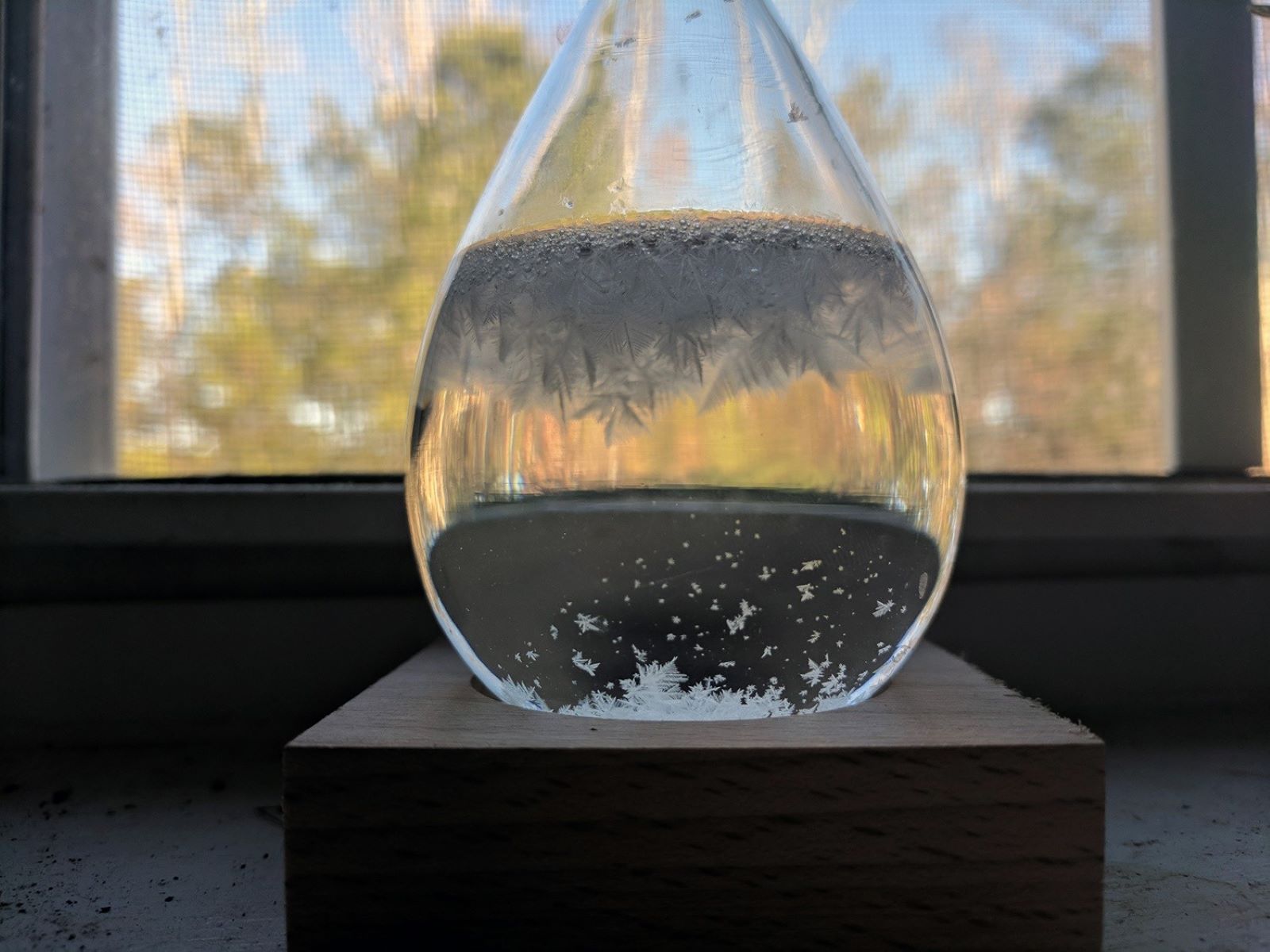Home>Furniture & Design>Interior Design Trends>What Is A Storm Glass


Interior Design Trends
What Is A Storm Glass
Published: February 6, 2024
Discover the latest interior design trend with the storm glass. Learn how this unique decorative piece adds a touch of elegance to any space. Explore the storm glass and its impact on interior design trends.
(Many of the links in this article redirect to a specific reviewed product. Your purchase of these products through affiliate links helps to generate commission for Storables.com, at no extra cost. Learn more)
Introduction
Storm glass, a fascinating and enigmatic device, has captured the curiosity of many with its mystical ability to predict weather changes. This intriguing instrument, often displayed as an elegant decorative piece, holds a rich history and a unique mechanism that continues to captivate enthusiasts and casual observers alike.
The allure of the storm glass lies in its enigmatic nature, as it seems to possess an almost mystical ability to forecast impending weather patterns. The history, functionality, and practical applications of the storm glass make it a compelling subject for exploration.
The storm glass, with its elegant and timeless design, has found its place as a conversation starter and a functional weather forecasting tool. Its allure lies not only in its practical applications but also in its aesthetic appeal, making it a popular choice for both weather enthusiasts and interior design aficionados.
The storm glass is a testament to the marriage of science and art, blending functionality with visual appeal. Its enigmatic nature and historical significance have contributed to its enduring popularity, making it a captivating subject for further exploration.
Key Takeaways:
- The storm glass, invented in the 18th century, predicts weather changes through crystal formations. It’s not just a tool, but also a captivating decorative piece and educational aid.
- By observing the storm glass’s crystals and considering environmental factors, individuals can predict weather patterns. It’s a timeless blend of science, art, and mystery.
Read more: How To Read A Storm Glass
History of Storm Glass
The history of the storm glass dates back to the 18th century when it was first invented by the British naval officer and amateur meteorologist, Admiral Robert FitzRoy. The concept behind the storm glass was based on the premise that changes in weather patterns could be predicted by observing the crystallization of certain substances in a liquid medium. This innovative approach to weather forecasting was a significant departure from traditional methods, marking the storm glass as a pioneering invention in meteorological science.
Admiral FitzRoy's invention of the storm glass was driven by a desire to provide sailors with a reliable means of predicting weather changes at sea. The storm glass was intended to serve as a valuable tool for enhancing maritime safety by alerting sailors to impending storms and adverse weather conditions. Its introduction marked a pivotal moment in the history of meteorology, as it represented a significant advancement in the understanding and prediction of weather phenomena.
The storm glass gained widespread recognition and popularity following its use during Charles Darwin's historic voyage aboard the HMS Beagle. Darwin, who had a keen interest in natural phenomena, was intrigued by the storm glass and its potential implications for weather forecasting. His observations and documentation of the storm glass's behavior contributed to its growing reputation as a reliable instrument for predicting weather patterns.
Throughout the 19th and 20th centuries, the storm glass continued to garner attention and acclaim, finding its place in homes, offices, and maritime settings. Its enigmatic nature and the air of mystery surrounding its functioning further fueled public fascination, solidifying its status as a captivating and enduring invention.
In contemporary times, the storm glass has transcended its original purpose as a maritime instrument and has become a cherished decorative item and conversation piece. Its historical significance, coupled with its aesthetic appeal, has ensured its continued relevance in the realms of both science and design.
The evolution of the storm glass from a practical weather forecasting tool to a revered decorative object underscores its enduring appeal and cultural significance. Its rich history, intertwined with the exploration of weather patterns and maritime navigation, has cemented its status as a timeless and captivating invention.
How Does a Storm Glass Work?
The mesmerizing operation of a storm glass is rooted in the principles of solubility and crystallization. Comprising a sealed glass container filled with a liquid solution, the storm glass contains a blend of ingredients such as distilled water, ethanol, potassium nitrate, ammonium chloride, and camphor. These components interact in response to fluctuations in temperature, forming crystals or precipitates that offer insights into impending weather changes.
When the ambient temperature shifts, the solution within the storm glass undergoes subtle transformations. As the temperature rises, the solubility of the ingredients increases, leading to the dissolution of any existing crystals. Conversely, a drop in temperature prompts the solutes to become less soluble, triggering the formation of crystals within the liquid medium.
The crystallization process within the storm glass is influenced by various environmental factors, including temperature, air pressure, and humidity. These intricate interactions give rise to unique crystal formations, which are interpreted to forecast weather patterns. For instance, the appearance of delicate, feathery crystals suggests the likelihood of fair weather, while the presence of dense, star-shaped crystals may indicate the onset of frost or snow.
The enigmatic behavior of the storm glass has sparked curiosity and debate among weather enthusiasts and scientists alike. While the precise mechanisms governing its operation continue to be a subject of intrigue, the storm glass remains a captivating fusion of art and science, offering a glimpse into the complexities of weather prediction.
The allure of the storm glass lies not only in its functional utility but also in its aesthetic charm, making it a cherished addition to interior spaces. Its ability to harness the subtle nuances of nature and translate them into visually captivating displays underscores its timeless appeal.
The enigmatic nature of the storm glass, coupled with its historical significance and enduring popularity, positions it as a remarkable testament to the fusion of scientific innovation and artistic elegance. As it continues to intrigue and inspire, the storm glass stands as a symbol of the enduring allure of enigmatic inventions.
Uses of Storm Glass
The storm glass, with its captivating blend of scientific intrigue and aesthetic allure, serves a range of practical and decorative purposes. Its multifaceted utility extends beyond weather forecasting, making it a versatile and cherished addition to diverse settings.
1. Weather Forecasting:
The primary function of the storm glass is to predict weather changes, offering valuable insights into impending atmospheric conditions. By observing the crystalline formations within the glass vessel, individuals can anticipate shifts in weather patterns, including the likelihood of fair weather, precipitation, or temperature fluctuations. This practical application makes the storm glass a valuable tool for weather enthusiasts, outdoor enthusiasts, and those with a keen interest in meteorology.
Read more: How To Replace A Storm Door Glass
2. Decorative Accent:
Beyond its functional utility, the storm glass serves as an elegant and captivating decorative accent in homes, offices, and commercial spaces. Its timeless design and enigmatic operation make it a compelling conversation piece and a visually striking addition to interior decor. Whether displayed on a mantelpiece, desk, or shelf, the storm glass adds a touch of sophistication and intrigue to any setting, blending scientific curiosity with aesthetic appeal.
3. Educational Tool:
In educational settings, the storm glass serves as a captivating teaching aid for illustrating principles of solubility, crystallization, and weather phenomena. Its enigmatic behavior sparks curiosity and fosters engagement, making it an ideal instrument for science classrooms, museums, and educational workshops. By observing the dynamic changes within the storm glass, students gain a tangible understanding of the intricate interactions between temperature and solubility, enriching their scientific knowledge and appreciation for natural processes.
4. Gift and Conversation Piece:
Due to its historical significance and timeless allure, the storm glass makes an exceptional gift for weather enthusiasts, history buffs, and individuals with an appreciation for unique and thought-provoking artifacts. Its enigmatic nature and elegant design ensure that it sparks conversations and piques curiosity, making it a memorable and cherished gift for special occasions.
5. Maritime and Nautical Settings:
With its origins rooted in maritime history, the storm glass remains relevant in nautical and maritime-themed settings. Whether displayed in maritime museums, coastal residences, or aboard seafaring vessels, the storm glass pays homage to its historical significance and its role in enhancing maritime safety through weather prediction.
In essence, the storm glass transcends its traditional function as a weather forecasting instrument, evolving into a versatile and captivating object with diverse applications. Its ability to blend scientific principles with aesthetic appeal positions it as a timeless and cherished artifact, enriching both practical and decorative realms.
Read more: How Does Storm Glass Work
How to Read a Storm Glass
Reading a storm glass involves observing the subtle changes within the liquid medium and interpreting the crystalline formations to gain insights into impending weather patterns. While the enigmatic nature of the storm glass adds an element of intrigue to the process, understanding the basic principles of interpretation can enhance the experience of using this captivating weather forecasting instrument.
Upon examining a storm glass, individuals may notice various types of crystalline formations, each of which carries distinct implications for weather prediction. Here are key guidelines for interpreting the behavior of a storm glass:
1. Observation of Crystals:
- Delicate, Feather-Like Crystals: The presence of delicate, feather-like crystals suspended in the liquid suggests the likelihood of fair weather or clear skies. This formation is often associated with stable atmospheric conditions and a low probability of precipitation.
- Cloudy or Hazy Appearance: If the liquid appears cloudy or exhibits a hazy appearance, it may indicate the potential for fog or humid weather. This observation suggests a rise in humidity and the possibility of misty or overcast conditions.
- Star-Shaped Crystals: The emergence of star-shaped crystals within the storm glass may signal the onset of frost or snow. This formation is indicative of a drop in temperature and the likelihood of wintry weather.
- Needle-Like Crystals: The presence of needle-like crystals points to the potential for windy or stormy weather. This formation suggests atmospheric instability and the possibility of gusty winds or turbulent conditions.
2. Temperature and Environmental Factors:
- Consider the Ambient Temperature: Observing the ambient temperature and its fluctuations can provide valuable context for interpreting the behavior of the storm glass. Changes in temperature influence the solubility of the ingredients within the glass, leading to the formation or dissolution of crystals.
- Account for Environmental Variations: Factors such as air pressure, humidity, and seasonal changes can impact the behavior of the storm glass. By considering these environmental variables, individuals can refine their interpretations and make more accurate weather predictions.
3. Historical Observations and Patterns:
- Documenting Observations: Keeping a record of the storm glass's behavior over time can reveal recurring patterns and correlations with specific weather conditions. By documenting observations and comparing them with actual weather outcomes, individuals can refine their ability to interpret the storm glass effectively.
Read more: How To Replace Glass In Storm Door
4. Contextual Analysis:
- Integration with Weather Forecasts: While the storm glass offers valuable insights, it is beneficial to integrate its observations with conventional weather forecasts. By combining the indications from the storm glass with meteorological predictions, individuals can gain a comprehensive understanding of impending weather patterns.
By honing their observational skills and familiarizing themselves with the unique characteristics of their storm glass, individuals can develop a nuanced understanding of its behavior and refine their ability to interpret its predictions. The process of reading a storm glass invites a sense of curiosity and engagement, offering a captivating blend of scientific observation and atmospheric intuition.
Conclusion
In conclusion, the storm glass stands as a captivating fusion of history, science, and art, offering a multifaceted appeal that transcends its traditional role as a weather forecasting instrument. Its rich historical lineage, dating back to the 18th century, underscores its enduring significance as an invention that has left an indelible mark on the realms of meteorology and maritime navigation. The storm glass's evolution from a practical tool for predicting weather changes at sea to a cherished decorative artifact reflects its timeless allure and cultural resonance.
The enigmatic operation of the storm glass, rooted in the principles of solubility and crystallization, continues to intrigue and inspire enthusiasts, educators, and interior design aficionados. Its ability to harness subtle environmental cues and translate them into visually captivating displays underscores its enduring relevance in contemporary settings. Whether used as a weather forecasting tool, a decorative accent, an educational instrument, or a maritime homage, the storm glass embodies a versatile and enduring appeal that transcends temporal and spatial boundaries.
The process of reading a storm glass, with its emphasis on observing crystalline formations and interpreting their implications for weather patterns, invites individuals to engage with the natural world in a nuanced and intuitive manner. By integrating historical observations, environmental factors, and contextual analysis, users can refine their ability to interpret the storm glass effectively, fostering a deeper appreciation for the intricate interplay between science and atmospheric phenomena.
As the storm glass continues to captivate and inspire, it serves as a testament to the enduring allure of enigmatic inventions that bridge the realms of scientific innovation and aesthetic elegance. Its enigmatic nature, historical significance, and multifaceted utility position it as a cherished artifact that enriches both practical and decorative domains, inviting individuals to embark on a journey of exploration and discovery.
In essence, the storm glass transcends its functional role as a weather forecasting instrument, emerging as a timeless and captivating artifact that embodies the enduring allure of enigmatic inventions. Its ability to blend scientific principles with aesthetic appeal underscores its status as a cherished and timeless creation, inviting individuals to embrace the mysteries of nature and the captivating fusion of art and science.
Frequently Asked Questions about What Is A Storm Glass
Was this page helpful?
At Storables.com, we guarantee accurate and reliable information. Our content, validated by Expert Board Contributors, is crafted following stringent Editorial Policies. We're committed to providing you with well-researched, expert-backed insights for all your informational needs.













0 thoughts on “What Is A Storm Glass”